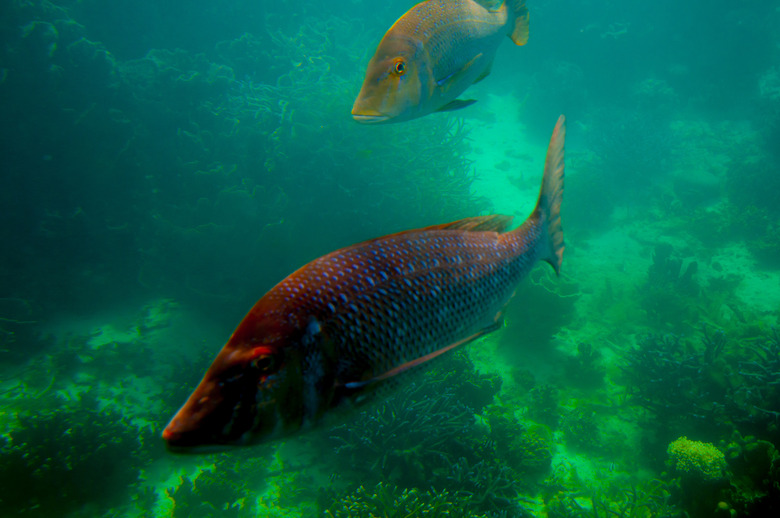Marine Animals That Eat Plants
Many marine animals are not vegetarians. Animals such as dolphin, shark, rays, polar bears and seals are almost exclusively predatory hunters. Herbivorous marine species consume phytoplankton and various forms of seaweed. Because seaweed must grow from the ocean floor up to the surface, seaweed is exclusively found in shallow water. Phytoplankton grows freely in the open ocean.
Larva
Larva
Many marine animals pass through a larval stage in their life cycle. These larvae often live among the phytoplankton and feed until they develop into their adult form and become proficient swimmers. These creatures are called zooplankton and include such species as sponges, anemones, worms, crabs and lobsters.
Mammals
Mammals
Manatees and dugongs are the only herbivorous mammals in the sea. They breathe air and spend their entire life in the water. These two species are very similar, with the primary difference being the shape of their tail. Both have a thick wrinkly skin that is covered in sparse coarse hair, similar to that of an elephant. They only need to return to the surface of the water approximately every 20 minutes to breathe, but typically breathe every three to five minutes. These animals have been known to live as long as 60 years. Manatees and dugongs live close to the shore, where their food source of sea lettuce is located. Unfortunately, this puts them at risk for encountering boats and other watercraft, accounting for loss of life and injury to these gentle creatures.
Fish
Fish
Although the percentage of herbivorous fish species is relatively low, these species often represent large numbers. Most species remain close to shore, where there is an abundance of sea vegetation to act as food and habitat for these plant-eating fish. Parrotfish, chubs, surgeonfish, blue tang and doctorfish are some of the more common herbivorous fish typically found around reef areas, which provide an ideal habitat with sufficient food and protective shelter.
Invertebrates
Invertebrates
Most invertebrates are opportunistic feeders, consuming whatever happens to float their way. However there are a few strictly vegetarian species, such as some varieties of sea snails, chiton and limpets. Zooplankton (the invertebrate larval form of many species) also predominantly consumes phytoplankton.
Crustaceans
Crustaceans
Some very small ocean-dwelling crustaceans are critical to maintaining a healthy ecosystem. Krill, for example, consumes phytoplankton and is beneficial in reducing the possibility of large blooms, called red tide. Red tide consumes huge amounts of oxygen, killing many marine species. Krill help to maintain balance.
Cite This Article
MLA
Thomas, Heather. "Marine Animals That Eat Plants" sciencing.com, https://www.sciencing.com/marine-animals-eat-plants-8067083/. 22 November 2019.
APA
Thomas, Heather. (2019, November 22). Marine Animals That Eat Plants. sciencing.com. Retrieved from https://www.sciencing.com/marine-animals-eat-plants-8067083/
Chicago
Thomas, Heather. Marine Animals That Eat Plants last modified March 24, 2022. https://www.sciencing.com/marine-animals-eat-plants-8067083/

